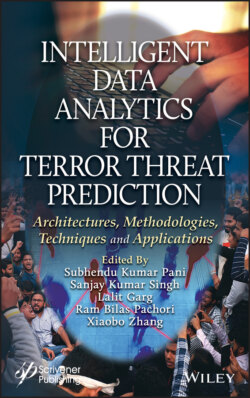Читать книгу Intelligent Data Analytics for Terror Threat Prediction - Группа авторов - Страница 13
1.1 Introduction
ОглавлениеSocial media like Facebook, Twitter, Sina Wiebo, YouTube and WhatsApp are becoming major online businesses. Social media uses computer-based technology with internet to ease the sharing of ideas, thoughts, and information by building of virtual networks and communities [1]. Nowadays, social media plays an important role for information diffusion [2]. Social networking sites like Facebook, Twitter, and WhatsApp have become popular over a short period of time with their user-friendly features [3]. It has advantages as well as disadvantages too [4]. Advantages of Information diffusion are, enable users to upload and share photos, videos, comment and like them, without hurting any communities, religions, or political parties, etc. The other side where people may share abusive photos, videos, terror activities or sensitive information about country, which are criminal activities come under cyber-crime.
Cyber-crime is a criminal activity which involves a computer and internet as part of it [5]. There are many activities that fall under cyber-crime such as passing rumors, online harassment, hacking emails, websites or databases, etc. [6]. To detect whether given data is rumor or fact, use text classification algorithms like Naïve Bayes theorem and support vector machine [7]. These classical algorithms are mainly used for classification purpose, and classify text data based on features and dimensions [8].
Detection of these cyber-crimes and finding the culprit involved becomes challenging for public, government and police departments as it is very difficult to detect and even hard to prove. As technology progresses, people can remotely access networked computer devices from different locations. Detection of Rumor Source in social media is also difficult as people can use various devices, IP addresses and emails to bully online, such as posting offensive images, videos or any rumors about others. So detection of these cyber-crimes and origin of those as early as possible in social networks will be helpful to combat the further diffusion and also punish the culprit involved [9]. After detection of rumors in social network it is required to combat them by finding people who spread first and punish them. Rumor source identification in social networks become very difficult as discussed earlier many techniques have been introduced, but very few become popular in finding origin of rumor.
Before going to find rumor source, there is a need of considering factors such as diffusion models, network structure, evaluation metrics and centrality measures [10]. Topology associates with Network structure is in tree or graph, and observation of network example complete observation, snapshot observation, and monitor observation, etc. [11]. If network topology is tree or graph use maximum likelihood (ML) estimator to estimate source [9]. Next factor consider diffusion models to get how fast information diffusing over network [10]. There are four diffusion models namely Susceptible-Infected-Susceptible (SIS), Susceptible-Infected (SI), Susceptible-Infected-Recoverable-Susceptible (SIRS) and Susceptible-Infected-Recoverable (SIR). SI model considers each node in any one of two states susceptible or infected [12]. SIS model considers three states susceptible-infected-susceptible, where infected node can again susceptible in future [13, 14]. SIR model also has three states but susceptible-infected-recovered, where infected node can be recovered by having immune power or taking medicines [15]. SIRS has four states of nodes such as susceptible-infected-recovered-susceptible, where recovered node may be susceptible in future [16]. Another factor consider in source detection is centrality measures [17]. There are several centrality measures such as degree centrality, closeness centrality, and betweenness centrality are popularly considered. All these factors considered to detect source in network are explained in following section.
Rumor source detection approaches are broadly divided into two main categories: 1) single source detection approach and 2) multiple sources detection approach [10]. Single source detection approaches are query-based, anti-rumor-based, network observation, etc. Multiple source detection approaches are network partitioning, ranking-based, community-based, approximation-based, etc. Single source detection using network observation again has three types of observations such as snapshot, complete and monitor observations, etc. Query-based observation allows to find source of rumor by asking queries to neighbors about rumors [18], anti-rumor-based is by diffusing anti-rumors into the network can get information about network using monitor-based observation and use this information to find rumor source [19]. Multiple sources of rumor is also a challenging task, and can be done by network partitioning using rumor centrality metric [20], community-based which follows SIR model and reverse diffusion [21]. All these models are useful to find rumor source in online social networks. Rumor source identification and punishing the culprit reduces further diffusion of rumors and cyber-crimes in social networks. This survey explains in the rest of the chapter social networks and their features in Section 1.2. What is cyber-crime, various cyber-crimes and their impacts, cyber-crimes in social networks are discussed in Section 1.3. Rumor detection using classification models in Section 1.4. Factors consider in rumor source identification and its classifications are discussed in Section 1.5. Rumor source detection categories such as single source and multiple sources of rumor in network are discussed in Section 1.6. Summary of this survey is discussed in Section 1.7.
